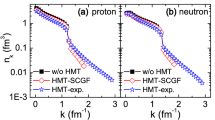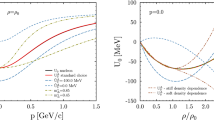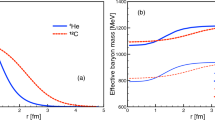Abstract
Within a transport model, we investigated the effects of the momentum dependence of the nuclear symmetry potential on the pion observables in central Sn + Sn collisions at 270 MeV/nucleon. To this end, the quantity \(U_\text {sym}^{\infty }(\rho _{0})\) (i.e., the value of the nuclear symmetry potential at the saturation density \(\rho _{0}\) and infinitely large nucleon momentum) was used to characterize the momentum dependence of the nuclear symmetry potential. With a certain L (i.e., the slope of the nuclear symmetry energy at \(\rho _{0}\)), the characteristic parameter \(U_\text {sym}^{\infty }(\rho _{0})\) of the symmetry potential significantly affects the production of \(\pi ^{-}\) and \(\pi ^{+}\) and their pion ratios. Moreover, by comparing the charged pion yields, pion ratios, and spectral pion ratios of the theoretical simulations for the reactions \(^{108}\)Sn + \(^{112}\)Sn and \(^{132}\)Sn + \(^{124}\)Sn with the corresponding data in the S\(\pi \)RIT experiments, we found that our results favor a constraint on \(U_\text {sym}^{\infty }(\rho _{0})\) (i.e., \(-160^{+18}_{-9}\) MeV), and L is also suggested within a range of 62.7 MeV\(<L<93.1\) MeV. In addition, the pion observable for \(^{197}\)Au + \(^{197}\)Au collisions at 400 MeV/nucleon also supports the extracted value for \(U_\text {sym}^{\infty }(\rho _{0})\).














Similar content being viewed by others
Notes
Approximately at \(t=13\) fm/c, the reaction approaches maximum compression, the nucleons in compression region are naturally in dense but low-energy phase.
The value of 81 MeV is the transition kinetic energy for the symmetry potential at \(1.5\rho _{0}\) with \(L=62.7\) MeV and \(U_\text {sym}^{\infty }(\rho _{0})=-240\) MeV.
References
S. Typel, B.A. Brown, Neutron radii and the neutron equation of state in relativistic models. Phys. Rev. C 64, 027302 (2001). https://doi.org/10.1103/PhysRevC.64.027302
E.E. Kolomeitsev, C. Hartnack, H.W. Barz et al., Transport theories for heavy-ion collisions in the 1 A GeV regime. J. Phys. G Nucl. Part. Phys. 31, S741 (2005). https://doi.org/10.1088/0954-3899/31/6/015
V. Baran, M. Colonna, V. Greco et al., Reaction dynamics with exotic nuclei. Phys. Rep. 410, 335 (2005). https://doi.org/10.1016/j.physrep.2004.12.004
B.A. Li, L.W. Chen, C.M. Ko, Recent progress and new challenges in isospin physics with heavy-ion reactions. Phys. Rep. 464, 113 (2008). https://doi.org/10.1016/j.physrep.2008.04.005
A. Tamii, I. Poltoratska, P. vonNeumann-Cosel et al., Complete electric dipole response and the neutron skin in \(^{208}\)Pb. Phys. Rev. Lett. 107, 062502 (2011). https://doi.org/10.1103/PhysRevLett.107.062502
X. Viñas, M. Centelles, X. Roca-Maza et al., Density dependence of the symmetry energy from neutron skin thickness in finite nuclei. Eur. Phys. J. A 50, 27 (2014). https://doi.org/10.1140/epja/i2014-14027-8
C.J. Horowitz, E.F. Brown, Y. Kim et al., A way forward in the study of the symmetry energy: experiment, theory, and observation. J. Phys. G Nucl. Part. Phys. 41, 093001 (2014). https://doi.org/10.1088/0954-3899/41/9/093001
P.G. Reinhard, W. Nazarewicz, Nuclear charge and neutron radii and nuclear matter: trend analysis in Skyrme density-functional-theory approach. Phys. Rev. C 93, 051303 (2016). https://doi.org/10.1103/PhysRevC.93.051303
M. Baldo, G.F. Burgio, The nuclear symmetry energy. Prog. Part. Nucl. Phys. 91, 203 (2016). https://doi.org/10.1016/j.ppnp.2016.06.006
C.W. Ma, Y.G. Ma, Shannon information entropy in heavy-ion collisions. Prog. Part. Nucl. Phys. 99, 120 (2018). https://doi.org/10.1016/j.ppnp.2018.01.002
H. Yu, D.Q. Fang, Y.G. Ma, Investigation of the symmetry energy of nuclear matter using isospin-dependent quantum molecular dynamics. Nucl. Sci. Tech. 31, 61 (2020). https://doi.org/10.1007/s41365-020-00766-x
C.W. Ma, H.L. Wei, X.Q. Liu et al., Nuclear fragments in projectile fragmentation reactions. Prog. Part. Nucl. Phys. 121, 103911 (2021). https://doi.org/10.1016/j.ppnp.2021.103911
J. Estee, W.G. Lynch, C.Y. Tsang et al., Probing the symmetry energy with the spectral pion ratio. Phys. Rev. Lett. 126, 162701 (2021). https://doi.org/10.1103/PhysRevLett.126.162701
C.Y. Tsang, M.B. Tsang, P. Danielewicz et al., Insights on Skyrme parameters from GW170817. Phys. Lett. B 796, 1 (2019). https://doi.org/10.1016/j.physletb.2019.05.055
Y. Lim, J.W. Holt, Neutron star tidal deformabilities constrained by nuclear theory and experiment. Phys. Rev. Lett. 121, 062701 (2018). https://doi.org/10.1103/PhysRevLett.121.062701
I. Tews, J. Margueron, S. Reddy, Critical examination of constraints on the equation of state of dense matter obtained from GW170817. Phys. Rev. C 98, 045804 (2018). https://doi.org/10.1103/PhysRevC.98.045804
A. Drago, A. Lavagno, G. Pagliara et al., Early appearance of \(\Delta \) isobars in neutron stars. Phys. Rev. C 90, 065809 (2014). https://doi.org/10.1103/PhysRevC.90.065809
A.W. Steiner, S. Gandolfi, Connecting neutron star observations to three-body forces in neutron matter and to the nuclear symmetry energy. Phys. Rev. Lett. 108, 081102 (2012). https://doi.org/10.1103/PhysRevLett.108.081102
C. Ducoin, J. Margueron, C. Providência et al., Core-crust transition in neutron stars: Predictivity of density developments. Phys. Rev. C 83, 045810 (2011). https://doi.org/10.1103/PhysRevC.83.045810
J.M. Lattimer, M. Prakash, The equation of state of hot, dense matter and neutron stars. Phys. Rep. 621, 127 (2016). https://doi.org/10.1016/j.physrep.2015.12.005
B.A. Brown, Constraints on the Skyrme equations of state from properties of doubly magic nuclei. Phys. Rev. Lett. 111, 232502 (2013). https://doi.org/10.1103/PhysRevLett.111.232502
B.A. Li, B.J. Cai, L.W. Chen et al., Isospin dependence of nucleon effective masses in neutron-rich matter. Nucl. Sci. Tech. 27, 141 (2016). https://doi.org/10.1007/s41365-016-0140-4
P. Danielewicz, R. Lacey, W.G. Lynch, Determination of the equation of state of dense matter. Science 298, 1592 (2002). https://doi.org/10.1126/science.1078070
M. Oertel, M. Hempel, T. Klahn et al., Equations of state for supernovae and compact stars. Rev. Mod. Phys. 89, 015007 (2017). https://doi.org/10.1103/RevModPhys.89.015007
B.J. Cai, L.W. Chen, Constraints on the skewness coefficient of symmetric nuclear matter within the nonlinear relativistic mean field model. Nucl. Sci. Tech. 28, 185 (2017). https://doi.org/10.1007/s41365-017-0329-1
G.F. Wei, Q.J. Zhi, X.W. Cao et al., Examination of an isospin-dependent single-nucleon momentum distribution for isospin-asymmetric nuclear matter in heavy-ion collisions. Nucl. Sci. Tech. 31, 71 (2020). https://doi.org/10.1007/s41365-020-00779-6
J. Liu, C. Gao, N. Wan et al., Basic quantities of the equation of state in isospin asymmetric nuclear matter. Nucl. Sci. Tech. 32, 117 (2021). https://doi.org/10.1007/s41365-021-00955-2
G.W. Hoffmann, W.R. Coker, Coupled-channel calculations of the energy dependence of the (\(p\),\(n\)) charge-exchange reaction. Phys. Rev. Lett. 29, 227 (1972). https://doi.org/10.1103/PhysRevLett.29.227
A.J. Koning, J.P. Delaroche, Local and global nucleon optical models from 1 KeV to 200 MeV. Nucl. Phys. A 713, 231 (2003). https://doi.org/10.1016/S0375-9474(02)01321-0
J.P. Jeukenne, C. Mahaux, R. Sartor, Dependence of the Fermi energy upon neutron excess. Phys. Rev. C 43, 2211 (1991). https://doi.org/10.1103/PhysRevC.43.2211
G. Jhang, J. Estee, J. Barney et al., Symmetry energy investigation with pion production from Sn+Sn systems. Phys. Lett. B 813, 136016 (2021). https://doi.org/10.1016/j.physletb.2020.136016
R. Shane, A.B. McIntosh, T. Isobe et al., S\(\pi \)RIT: a time-projection chamber for symmetry-energy studies. Nucl. Instr. Meth. A 784, 513 (2015). https://doi.org/10.1016/j.nima.2015.01.026
W. Reisdorf, A. Andronic, R. Averbeck et al., Systematics of central heavy ion collisions in the regime. Nucl. Phys. A 848, 366 (2010). https://doi.org/10.1016/j.nuclphysa.2010.09.008
G.C. Yong, Symmetry energy extracted from the S\(\pi \)RIT pion data in Sn + Sn systems. Phys. Rev. C 104, 014613 (2021). https://doi.org/10.1103/PhysRevC.104.014613
R. Subedi, R. Shneor, P. Monaghan et al., Probing cold dense nuclear matter. Science 320, 1476 (2008). https://doi.org/10.1126/science.1156675
L.B. Weinstein, E. Piasetzky, D.W. Higinbotham et al., Short range correlations and the EMC effect. Phys. Rev. Lett. 106, 052301 (2011). https://doi.org/10.1103/PhysRevLett.106.052301
M.M. Sargsian, New properties of the high-momentum distribution of nucleons in asymmetric nuclei. Phys. Rev. C 89, 034305 (2014). https://doi.org/10.1103/PhysRevC.89.034305
C.C. Degli Atti, In-medium short-range dynamics of nucleons: recent theoretical and experimental advances. Phys. Rep. 590, 1 (2015). https://doi.org/10.1016/j.physrep.2015.06.002
O. Hen, M. Sargsian, L.B. Weinstein et al., Momentum sharing in imbalanced Fermi systems. Science 346, 614 (2014). https://doi.org/10.1126/science.1256785
M. Duer, O. Hen, E. Piasetzky et al., Probing high-momentum protons and neutrons in neutron-rich nuclei. Nature 560, 617 (2018). https://doi.org/10.1038/s41586-018-0400-z
K.A. Brueckner, J. Dabrowski, Symmetry energy and the isotopic spin dependence of the single-particle potential in nuclear matter. Phys. Rev. 134, B722 (1964). https://doi.org/10.1103/PhysRev.134.B722
J. Dabrowski, P. Haensel, Spin and spin-isospin symmetry energy of nuclear matter. Phys. Rev. C 7, 916 (1973). https://doi.org/10.1103/PhysRevC.7.916
V. Giordano, M. Colonna, M.D. Toro et al., Isospin emission and flow at high baryon density: a test of the symmetry potential. Phys. Rev. C 81, 044611 (2010). https://doi.org/10.1103/PhysRevC.81.044611
J. Xu, L.W. Chen, M.B. Tsang et al., Understanding transport simulations of heavy-ion collisions at 100 A and 400 A MeV: comparison of heavy-ion transport codes under controlled conditions. Phys. Rev. C 93, 044609 (2016). https://doi.org/10.1103/PhysRevC.93.044609
Y.X. Zhang, Y.J. Wang, M. Colonna et al., Comparison of heavy-ion transport simulations: collision integral in a box. Phys. Rev. C 97, 034625 (2018). https://doi.org/10.1103/PhysRevC.97.034625
A. Ono, J. Xu, M. Colonna et al., Comparison of heavy-ion transport simulations: collision integral with pions and \(\Delta \) resonances in a box. Phys. Rev. C 100, 044617 (2019). https://doi.org/10.1103/PhysRevC.100.044617
M. Colonna, Y.X. Zhang, Y.J. Wang et al., Comparison of heavy-ion transport simulations: mean-field dynamics in a box. Phys. Rev. C 104, 024603 (2021). https://doi.org/10.1103/PhysRevC.104.024603
H. Wolter, M. Colonna, D. Cozma et al., Transport model comparison studies of intermediate-energy heavy-ion collisions. Prog. Part. Nucl. Phys. 125, 103962 (2022). https://doi.org/10.1016/j.ppnp.2022.103962
C.B. Das, S. Das Gupta, C. Gale et al., Momentum dependence of symmetry potential in asymmetric nuclear matter for transport model calculations. Phys. Rev. C 67, 034611 (2003). https://doi.org/10.1103/PhysRevC.67.034611
B.A. Li, C.B. Das, S. Das Gupta et al., Momentum dependence of the symmetry potential and nuclear reactions induced by neutron-rich nuclei at RIA. Phys. Rev. C 69, 011603 (2004). https://doi.org/10.1103/PhysRevC.69.011603
L.W. Chen, B.A. Li, A note of an improved MDI interaction for transport model simulations of heavy ion collisions (Unpublished, Texas A &M University-Commerce, 2010)
C. Xu, B.A. Li, Improved single particle potential for transport model simulations of nuclear reactions induced by rare isotope beams. Phys. Rev. C 81, 044603 (2010). https://doi.org/10.1103/PhysRevC.81.044603
L.W. Chen, C.M. Ko, B.A. Li et al., Probing isospin- and momentum-dependent nuclear effective interactions in neutron-rich matter. Eur. Phys. J. A 50, 29 (2014). https://doi.org/10.1140/epja/i2014-14029-6
G.F. Wei, C. Xu, W. Xie et al., Effects of density-dependent scenarios of in-medium nucleon-nucleon interactions in heavy-ion collisions. Phys. Rev. C 102, 024614 (2020). https://doi.org/10.1103/PhysRevC.102.024614
J. Dechargé, D. Gogny, Hartree-fock-bogolyubov calculations with the D1 effective interaction on spherical nuclei. Phys. Rev. C 21, 1568 (1980). https://doi.org/10.1103/PhysRevC.21.1568
T. Duguet, P. Bonche, Density dependence of two-body interactions for beyond-mean-field calculations. Phys. Rev. C 67, 054308 (2003). https://doi.org/10.1103/PhysRevC.67.054308
J.W. Negele, Structure of finite nuclei in the local-density approximation. Phys. Rev. C 1, 1260 (1970). https://doi.org/10.1103/PhysRevC.1.1260
J. Xu, L.W. Chen, B.A. Li, Thermal properties of asymmetric nuclear matter with an improved isospin- and momentum-dependent interaction. Phys. Rev. C 91, 014611 (2015). https://doi.org/10.1103/PhysRevC.91.014611
H.Y. Kong, Y. Xia, J. Xu et al., Reexamination of the neutron-to-proton-ratio puzzle in intermediate-energy heavy-ion collisions. Phys. Rev. C 91, 047601 (2015). https://doi.org/10.1103/PhysRevC.91.047601
H.Y. Kong, J. Xu, L.W. Chen et al., Constraining simultaneously nuclear symmetry energy and neutron-proton effective mass splitting with nucleus giant resonances using a dynamical approach. Phys. Rev. C 95, 034324 (2017). https://doi.org/10.1103/PhysRevC.95.034324
S. Hama, B.C. Clark, E.D. Cooper et al., Global Dirac optical potentials for elastic proton scattering from heavy nuclei. Phys. Rev. C 41, 2737 (1990). https://doi.org/10.1103/PhysRevC.41.2737
O. Buss, T. Gaitanos, K. Gallmeister et al., Transport-theoretical description of nuclear reactions. Phys. Rep. 512, 1 (2012). https://doi.org/10.1016/j.physrep.2011.12.001
M. Ericson, T.E.O. Ericson, Optical properties of low-energy pions in nuclei. Ann. Phys. 36, 323 (1966). https://doi.org/10.1016/0003-4916(66)90302-2
C. García-Recio, E. Oset, L.L. Salcedo, S-wave optical potential in pionic atoms. Phys. Rev. C 37, 194 (1988). https://doi.org/10.1103/PhysRevC.37.194
J. Nieves, E. Oset, C. García-Recio, Many-body approach to low-energy pion-nucleus scattering. Nucl. Phys. A 554, 554 (1993). https://doi.org/10.1016/0375-9474(93)90246-T
Z. Zhang, C.M. Ko, Medium effects on pion production in heavy ion collisions. Phys. Rev. C 95, 064604 (2017). https://doi.org/10.1103/PhysRevC.95.064604
G.F. Wei, C. Liu, X.W. Cao et al., Necessity of self-consistent calculations for the electromagnetic field in probing the nuclear symmetry energy using pion observables in heavy-ion collisions. Phys. Rev. C 103, 054607 (2021). https://doi.org/10.1103/PhysRevC.103.054607
G.F. Wei, B.A. Li, G.C. Yong et al., Effects of retarded electrical fields on observables sensitive to the high-density behavior of the nuclear symmetry energy in heavy-ion collisions at intermediate energies. Phys. Rev. C 97, 034620 (2018). https://doi.org/10.1103/PhysRevC.97.034620
G.F. Wei, G.C. Yong, L. Ou et al., Beam-energy dependence of the relativistic retardation effects of electrical fields on the \(\pi ^{-}/\pi ^{+}\) ratio in heavy-ion collisions. Phys. Rev. C 98, 024618 (2018). https://doi.org/10.1103/PhysRevC.98.024618
B.A. Li, G.C. Yong, W. Zuo, Near-threshold pion production with radioactive beams. Phys. Rev. C 71, 014608 (2005). https://doi.org/10.1103/PhysRevC.71.014608
P. Danielewicz, P. Singh, J. Lee, Symmetry energy III: Isovector skins. Nucl. Phys. A 958, 147 (2017). https://doi.org/10.1016/j.nuclphysa.2016.11.008
M.D. Cozma, Feasibility of constraining the curvature parameter of the symmetry energy using elliptic flow data. Eur. Phys. J. A 54, 40 (2018). https://doi.org/10.1140/epja/i2018-12470-1
Z. Zhang, C.M. Ko, Effects of energy conservation on equilibrium properties of hot asymmetric nuclear matter. Phys. Rev. C 97, 014610 (2018). https://doi.org/10.1103/PhysRevC.97.014610
J.R. Stone, P. Danielewicz, Y. Iwata, Proton and neutron density distributions at supranormal density in low- and medium-energy heavy-ion collisions. Phys. Rev. C 96, 014612 (2017). https://doi.org/10.1103/PhysRevC.96.014612
P. Russotto, S. Gannon, S. Kupny et al., Results of the ASY-EOS experiment at GSI: the symmetry energy at suprasaturation density. Phys. Rev. C 94, 034608 (2016). https://doi.org/10.1103/PhysRevC.94.034608
Acknowledgements
Gao-Feng Wei would like to thank Profs. Bao-An Li and Gao-Chan Yong for their helpful discussions.
Author information
Authors and Affiliations
Contributions
All authors contributed to the study conception and design. Material preparation, data collection and analysis were performed by Gao-Feng Wei, Xin Huang and Qi-Jun Zhi. The first draft of the manuscript was written by Gao-Feng Wei, and all authors commented on previous versions of the manuscript. All authors read and approved the final manuscript.
Corresponding author
Additional information
This work was supported by the National Natural Science Foundation of China (Nos. 11965008 and 11405128), the Guizhou Provincial Science and Technology Foundation (No. [2020]1Y034), and the PhD-funded project of Guizhou Normal University (No. GZNUD[2018]11).
Rights and permissions
Springer Nature or its licensor (e.g. a society or other partner) holds exclusive rights to this article under a publishing agreement with the author(s) or other rightsholder(s); author self-archiving of the accepted manuscript version of this article is solely governed by the terms of such publishing agreement and applicable law.
About this article
Cite this article
Wei, GF., Huang, X., Zhi, QJ. et al. Effects of the momentum dependence of nuclear symmetry potential on pion observables in Sn + Sn collisions at 270 MeV/nucleon. NUCL SCI TECH 33, 163 (2022). https://doi.org/10.1007/s41365-022-01146-3
Received:
Revised:
Accepted:
Published:
DOI: https://doi.org/10.1007/s41365-022-01146-3




